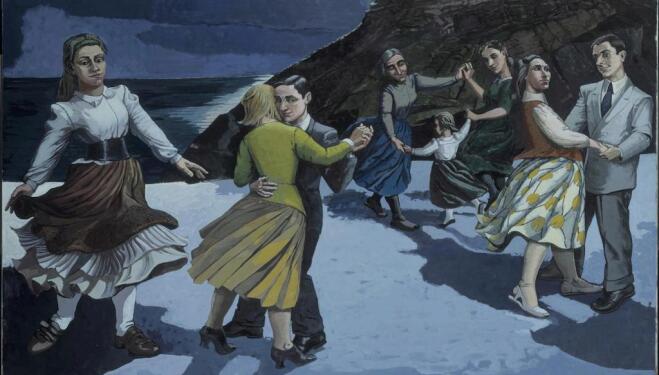
Born in Switzerland in 1889 Taeuber-Arp began her career designing textiles. She went on to become a teacher, architect, performer, interior designer and the editor of an international arts magazine. It was in Switzerland that she met her husband, the artist Hans (Jean) Arp, and her career has largely overshadowed by his. But this exhibition sets out to put that right, for Taeuber-Arp’s work deserves to be recognised for its wit and variety. Perhaps more than any artist of her generation, she blurred the boundaries between fine art and the applied arts, elevating interior design with her abstract touch and adding dynamism to her paintings with clever compositions and 3D additions.
There is action in everything Taeuber-Arp made. Where much abstract art of the time seems static and flat, the circles and lines in her paintings seem to tip and roll. This interest in movement began, perhaps, with her experiments in dance and performance. During the First World War, neutral Switzerland became a haven for artists and performers, making Zurich a cultural centre for the avant-garde. She became friends with dancers and Dadaists and embraced performance as part of her own practice.

Sophie Taeuber-Arp's marionettes for King Stag. (c) Tate, Seraphina Neville
In 1918, she was commissioned by the Swiss Marionette Theatre to design sets and puppets for the fairy-tale play King Stag. The marionettes are on display here, made from turned wood, painted in bright colours and adorned with feathers. In fact, Taeuber-Arp embraced a plethora of materials, from beads and embroidery, to stained glass and lace. Anything she touched could be elevated to the lofty heights of abstraction. It was her aim, she is quoted as saying in this exhibition, 'to make the things we own more beautiful.'
In 1926, together with her husband and the Dutch artist Theo van Doesburg, Taeuber-Arp redesigned a wing of the Aubette building in Strasbourg. She also designed a house for herself and Arp in the town of Clamart near Paris, which would become a centre of activity for visiting artist friends. She combined living and studio space and created furniture with interchangeable parts, proving herself once more the versatile designer.

Sophie Taeuber-Arp.Colored Gradation. 1939. Kunstmuseum Bern.
When German troops entered Paris in 1940, Taeuber-Arp and her husband left their home in Clamart and became artists in exile. Being constantly on the move and with little space to work, she relied on lightweight materials, such as paper and pencils. This period saw a departure from the solid certainty of geometric shapes. Instead, she made compositions of meandering lines, and it is tempting to see these as a reflection of her newly peripatetic life. Sadly, she died in January 1943, aged just 53, from accidental carbon monoxide poisoning. Like many female artists who married men of the same profession, Taeuber-Arp's name faded from the annals. But this joyful retrospective at Tate Modern should go some way to restoring her name as a true innovator and visionary.
| What | Sophie Taeuber-Arp exhibition, Tate Modern review |
| Where | Tate Modern, Bankside, London, SE1 9TG | MAP |
| Nearest tube | Waterloo (underground) |
| When |
15 Jul 21 – 17 Oct 21, Sunday - Thursday 10AM - 6PM; Friday and Saturday 10AM - 10PM |
| Price | £TBD |
| Website | Click here for more information |
.jpg)





